Authors: JieXuan Chua, Brian Chen, Binance Research
Translation: 0xjx, Golden Finance
1. Key Points of This Article
- In recent months, the hot topic of discussion in the crypto community has been tokens with high valuations and low initial circulation. This market structure has raised concerns about the limited sustainable upside for traders after TGE.
- Data from CoinMarketCap and Token Unlocks confirms the increasingly evident trend of tokens being issued with low circulation and high valuations. It is worth noting that it is estimated that approximately $155 billion worth of tokens will be unlocked from 2024 to 2030. If buyer demand and capital inflows do not increase correspondingly, the influx of such a large quantity of tokens into the market will create selling pressure.
- Factors such as inflow of private market capital, aggressive valuations, and optimistic market sentiment have contributed to the trend of tokens being issued with high fully diluted valuations ("FDV").
- The current market conditions require investors to be more selective and cautious, considering the fundamental aspects of projects such as token economics, valuations, and products. Project teams may also need to consider the long-term impact related to token economic design.
- VCs continue to play an important role in our industry and can collaborate with project teams to ensure fair supply distribution and reasonable valuations.
2. Market Observations
In recent months, the hot topic of discussion in the crypto community has been tokens with high valuations and low initial circulation. This market structure has raised concerns about the limited sustainable upside for traders after TGE.
These concerns are not unfounded. Tokens are being issued with low circulation, and most tokens are expected to be released in the future. In a bull market, due to limited liquidity available for trading at the time of issuance, these tokens may experience rapid price increases. However, it is clear that such price growth is not sustainable when a wave of token supply is unlocked.
Furthermore, the FDV of newly issued tokens is comparable to established layer 1 or DeFi tokens that have been tested over time and have user appeal. Overall, market participants are now aware of the impact of tokens with low circulation and high FDV.
In this report, we will delve more deeply into this market trend. We will first provide a detailed overview of our observations on the increasing issuance of high FDV tokens and discuss the potential market impact and its significance. Then, we will analyze the fundamental reasons for this trend, particularly the role of private market activity. Finally, we will offer some recommendations to identify and mitigate the negative impact of this trend, with a focus on tailored advice for investors and project teams.
2.1 Low Circulation, High FDV
There is a clear trend where recently issued tokens are being issued with high valuations and low circulation. This is particularly evident when comparing the market capitalization ("MC") to FDV ratio of tokens issued in the past few years—tokens issued in 2024 have the lowest MC/FDV ratio. This indicates that there will be a large amount of tokens unlocked in the future.
Figure 1: The MC/FDV of tokens issued in 2024 is the lowest in the past three years
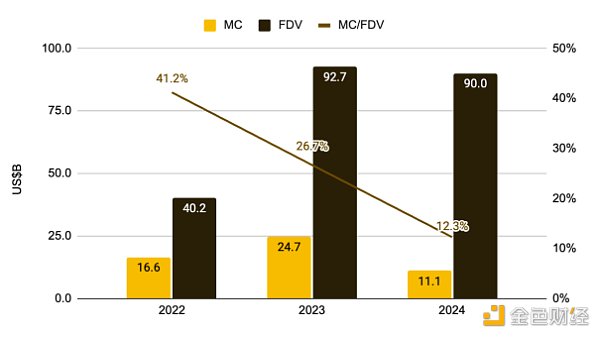
Source: Twitter (@thedefivillain), CoinMarketCap, Binance Research, as of April 14, 2024
Figure 1 highlights the widening gap in these indicators over time. It is worth noting that, despite 2024 having just begun, the FDV of tokens issued in recent months is already close to the total for 2023, highlighting the widespread presence of high valuation tokens.
The MC/FDV of tokens issued in 2024 is 12.3%, indicating a large number of tokens entering circulation in the future. This also implies that, in order for these tokens to maintain their current prices in the coming years, approximately $8 billion in demand-side liquidity will be needed to match the increase in supply. While market cycles may change, this may not be an easy task.
Examining some recently issued tokens reveals the fundamental reasons for the high FDV in 2024. Figure 2 shows the percentages of circulating and locked supplies for several tokens issued in recent months. The low circulation supply, as low as 6% and not exceeding 20%, is the obvious reason.
Figure 2: Circulating supply of recently issued tokens is extremely low
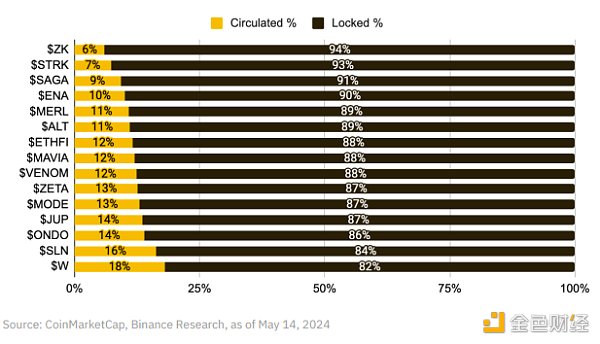
Source: CoinMarketCap, Binance Research, as of May 14, 2024
For the same level of demand, the low circulation supply has led to initially high token prices, driving the higher FDV.
Comparing the peak FDV of the same set of tokens with the median FDV of the top ten tokens in the market (excluding BTC, ETH, and stablecoins) provides a sense of the relative valuations of recently listed tokens. At their peak, the valuations of some tokens are similar to those of the largest tokens in the market, which have been in existence for many years.
Figure 3: At their peak, the valuations of some recently issued tokens are similar to those of the largest tokens in the market
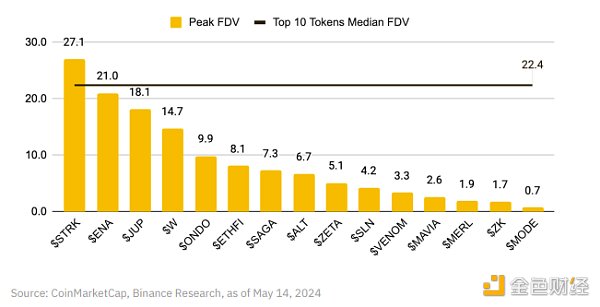
Source: CoinMarketCap, Binance Research, as of May 14, 2024
It is important to note that FDV alone cannot fully describe the situation, and they are not as meaningful as FDV ratios (e.g., FDV/total locked value, FDV/revenue, etc.), as these ratios consider operational metrics.
In the past few months, many projects have issued their tokens, many of which have low circulation and high FDV. Due to the large number of such projects, we have only selected a few for demonstration. Please note that this is only to illustrate the widespread presence of tokens with low circulation and high FDV, and does not reflect a negative assessment of the value or potential of the selected projects, as there are many other factors at play.
2.2 Market Impact and Significance
The issuance of tokens with low circulation has had an impact on market dynamics, particularly increasing selling pressure. According to Token Unlocks' report, it is estimated that approximately $155 billion worth of tokens will be unlocked from 2024 to 2030.
While this figure is an estimate, its significance is evident—there is expected to be a large amount of token supply released in the coming years, and if there is no corresponding capital inflow, many tokens will face significant selling pressure.
Therefore, understanding token unlock schedules and tracking them is crucial for investors to prevent being caught off guard when tokens undergo large-scale unlocking.
Figure 4: $155 billion expected to be unlocked in the coming years
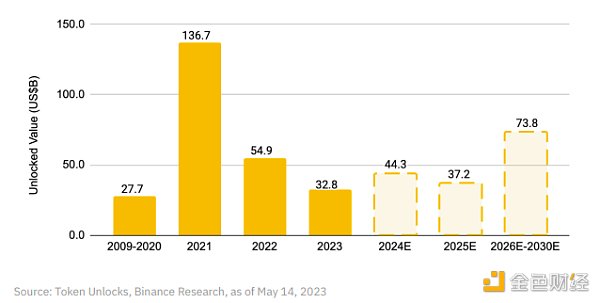
Source: Token Unlocks, Binance Research, as of May 14, 2023
A related observation is that meme tokens have outperformed other tokens so far this year. In addition to significant awareness and strong speculative demand, the token supply structure has also played a role in their upward trend this year.
Figure 5: Meme tokens have been the best-performing theme so far this year
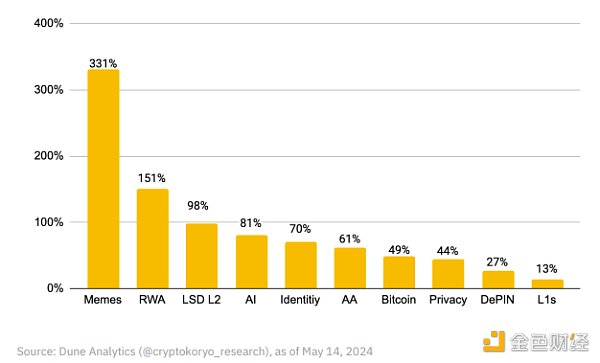
Source: Dune Analytics (@cryptokoryo_research), as of May 14, 2024
Most meme tokens have already been unlocked and circulated at TGE, eliminating the selling pressure from future dilution. Many of them had an MC/FDV ratio of 1 at issuance, meaning holders would not be further diluted by token issuance. This structure has played a role in the attractiveness of meme tokens, especially as awareness of the impact of large-scale token unlocks has increased. While the success of meme tokens should not be solely attributed to dissatisfaction with low-circulation tokens, it is clear that retail investors have shown great interest in meme tokens, even though these tokens may lack utility.
Similar to the famous "GameStop short squeeze" event in the stock market, many retail investors view meme tokens as a means to counter the advantage gained by institutions in private rounds. This is because meme tokens are typically issued in a way that is open to anyone, with little opportunity for institutional participants to acquire tokens at a low price in advance. Therefore, meme tokens have become an important theme in the current market, continuously attracting significant trading volume and strong price fluctuations.
3. How Did We Get Here?
High valuations, coupled with sustained selling pressure from token unlocks, have had a structurally negative impact on token prices. However, as observed in the previous section, this situation has become more common in recent years. Several factors have contributed to this situation.
3.1 Influx of Private Market Capital
VC funds are increasingly playing a key role in the crypto investment space. Despite natural fluctuations in investment capital due to market cycles, VC capital flowing into the crypto space has been steadily increasing since 2017. Over $91 billion in total VC funding has been invested in crypto projects since 2017, demonstrating the importance of VC in providing necessary funding for projects.
Figure 6: Cumulative VC funding has exceeded $91 billion since 2017
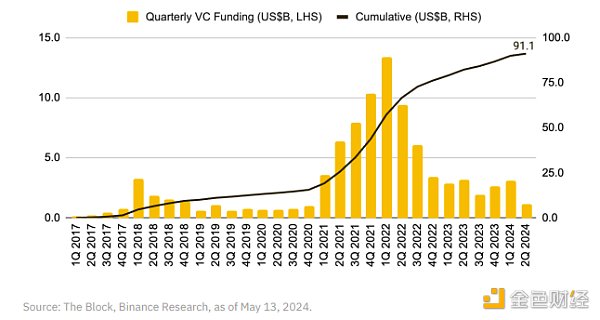
Source: The Block, Binance Research, as of May 13, 2024
However, the significant increase in investment has also led to a corresponding increase in the influence of VC in shaping crypto market valuations. With more funds flowing into this space and VC participating in more transactions, they essentially drive up valuations.
As a result, when tokens are launched on the public market, their prices and valuations have already been inflated. In fact, large-scale private market fundraising has led to tokens being valued at billions of dollars at launch, making it more difficult for public market investors to profit from future growth.
3.2 Aggressive Valuations
The strong market performance this year has fueled market sentiment and led to more aggressive trading activity. This has made some investors more willing to invest at higher valuations.
Given that valuations in the millions of dollars have become the norm, a cautious approach to valuations may actually put VCs at a disadvantage in front of their LPs, as it implies missing out on most of the trading activity during a surge. While market activity is still below the peak of 2022, crypto trading volume in the first quarter of 2024 increased by 52.1% compared to the previous quarter, reaching the highest level in nearly two years.
Figure 7: Increased trading activity this year
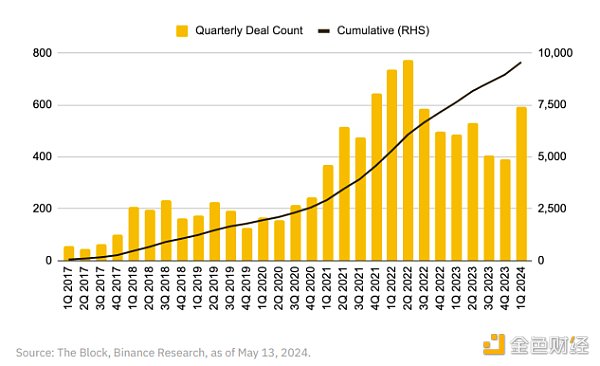
Furthermore, in a bull market, VCs have an incentive to continue deploying capital. As long as the music keeps playing, high valuations will enhance the performance metrics of VCs. Additionally, for projects, raising a large amount of funds at a high valuation is advantageous, as it provides them with operational capital without significant dilution. This also demonstrates the strong support of "smart money."
Overall, raising funds at high valuations in private rounds incentivizes stakeholders to release tokens with higher fully diluted valuations (FDV) publicly.
3.3 Optimistic Market Sentiment
With the crypto market cap growing by 61% in the first quarter of this year, market sentiment during this period has been clearly very positive. CoinMarketCap's Fear and Greed Index spent 69 out of 91 days in the "greed" and "extreme greed" range in the first quarter. Correspondingly, project teams were able to capitalize on this positive investor sentiment to raise funds at higher valuations in the first quarter.
This is evident from the increase in valuations in the first quarter. Specifically, VC-backed crypto companies saw a rebound of over 70% in pre-money valuations in the first quarter of 2024. This indicates that, on average, projects were able to raise the same amount of funds with reduced dilution compared to the previous quarter.
Figure 8: Rebound in pre-money valuations in the first quarter of 2024
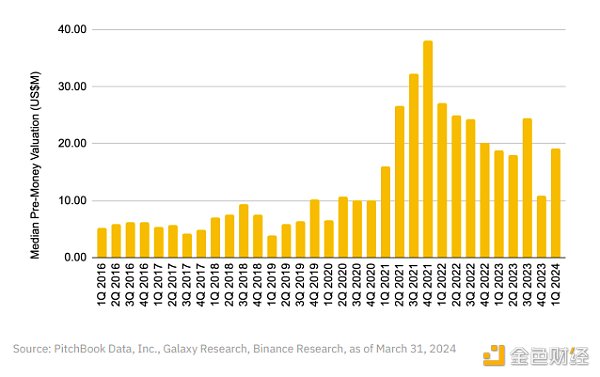
4. Some Considerations
4.1 For Investors: Fundamentals Matter
The current market structure requires investors to be more selective. Given that many projects have high valuations from the start, the probability of "speculating" on new tokens for sustainable returns is low. Most of the upside and easy money-making opportunities may have already been seized by early private market investors.
Whether investing in private rounds or at token generation events (TGE), investors should conduct thorough due diligence and establish their own investment processes. Some fundamental indicators and aspects worth considering include, but are not limited to:
- Token economics: The importance of unlock schedules and periods cannot be underestimated, as they directly impact the token supply in the market. Without a corresponding increase in demand, it can lead to excessive selling pressure on token prices.
- Valuations: FDV provides a rough sense of scale, but it is not very meaningful on its own. Evaluate valuations relative to other competitors and valuation ratios that change over time (e.g., FDV/revenue, FDV/total locked value, etc.).
- Product: Consider the project's position in the product lifecycle (e.g., whitepaper stage or product already live on the mainnet). Is there product-market fit? Observe user activity (e.g., number of daily active addresses, daily transaction volume, etc.).
- People: This includes the team and community. What are the backgrounds of the founders, and how are they contributing to the project? How engaged is the community, and what excites them most about the project?
Taking the time to evaluate fundamentals rather than actively chasing the next shiny token will help identify and avoid obvious risks and pitfalls. As Warren Buffett said, "Only when the tide goes out do you discover who's been swimming naked." Everything usually looks good until the music stops. Avoid being the last holder.
4.2 For Project Teams: Consider Long-Term Development
Running a project is not easy, considering the many aspects and stakeholders that need to be considered. Decisions are complex and cannot please everyone. Nevertheless, we believe that one of the guiding principles for decision-making is to consider long-term development.
- Token economics: Launching tokens with low circulation and high FDV may help initial price increases due to limited token supply. However, subsequent unlocks can cause significant selling pressure on tokens. The loyal token holders of the project (arguably one of the most important groups in the community) will suffer as a result. Poor token performance may also deter new ecosystem participants from joining the network, as incentive mechanisms decrease.
In this regard, token distribution, unlock, and ownership plans should be carefully considered. While token economics is more of an art than a science, with no magic numbers or methods, it is clear that the recent launch of tokens has very low circulation, as shown in Figure 2. To mitigate the risk of sudden supply increases, teams and investors can consider token burn mechanisms, aligning ownership plans with set milestones, and increasing initial circulation supply during TGE.
- Product: While tokens can help garner market attention and serve as a good user acquisition tool, a viable product is key to creating value, user retention, and sustainable growth. Having at least a minimum viable product before TGE will help investors and users better understand the project's value proposition and determine product-market fit. Ideally, launching a product with significant user appeal can promote a successful TGE by boosting confidence and attracting high-quality investors and users. In the long run, the product adds intrinsic value to the token and contributes to token price performance.
With the rebound in fundraising activity in the first quarter, project founders were able to capitalize on the rising sentiment to achieve higher valuations. However, while intuitively raising funds at high valuations makes sense (who would refuse to raise the same amount of funds with less dilution?), it has long-term implications. Projects that raise funds at prices significantly higher than their intrinsic value will need to justify this premium in future subsequent private rounds or on the public market. If they fail to do so, the token price may tend towards its true value. Investors will suffer losses, and project teams may struggle to reverse community sentiment.
5. Conclusion
Token economics is undoubtedly one of the most important considerations for investors and project teams. Every design decision comes with a series of trade-offs and considerations. While launching tokens with initially low circulation supply may drive initial price increases, stable unlocks and issuances of tokens will create selling pressure and impact long-term performance. If such a trend becomes an industry norm, the unlocking of billions of tokens in the coming years will make sustainable growth increasingly difficult unless corresponding fund inflows can match these unlocks.
VCs continue to play a crucial role in our industry, and tokens backed by VCs are not universally bad. Project teams and VCs should work together to ensure fair and reasonable supply distribution and valuations.
免责声明:本文章仅代表作者个人观点,不代表本平台的立场和观点。本文章仅供信息分享,不构成对任何人的任何投资建议。用户与作者之间的任何争议,与本平台无关。如网页中刊载的文章或图片涉及侵权,请提供相关的权利证明和身份证明发送邮件到support@aicoin.com,本平台相关工作人员将会进行核查。




